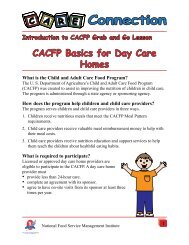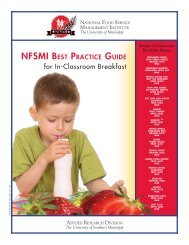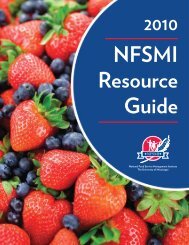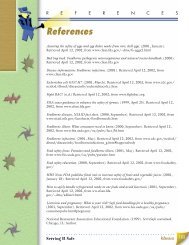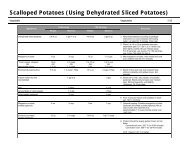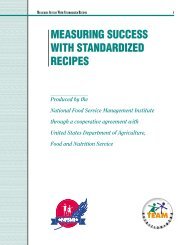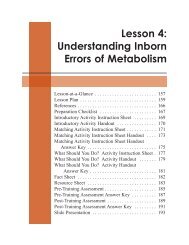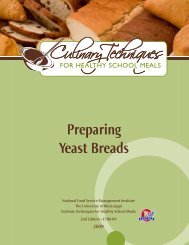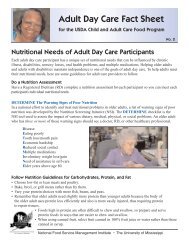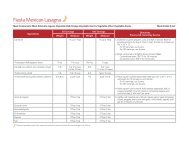financial management information system - National Food Service ...
financial management information system - National Food Service ...
financial management information system - National Food Service ...
Create successful ePaper yourself
Turn your PDF publications into a flip-book with our unique Google optimized e-Paper software.
S ECTION 4FINANCIAL A NALYSIS AND P ROGRAM E VALUATIONLabor Cost PercentageA general labor cost percentage is determined by dividing total labor costs by total revenue. This percentage is useful to schoolfoodservice administrators as a benchmark for making comparisons. These comparisons can be made from school to schoolwithin a district or from district to district within a state or region. Cost percentages higher than anticipated may be anindication that too many labor hours are being allocated for the number of meals served. The labor cost percentage iscalculated using the following formula:Labor Cost Percentage = Payroll, Benefits, Other Related ExpensesTotal RevenueExample: A school foodservice operation had an annual payroll, including benefits and other labor expenses, of $400,000.They had an annual revenue of $800,000. The annual labor cost percentage is calculated as follows:$400,000$800,000= .50 or approximately 50%This percentage tells the SFS administrator that for every $1 in revenue earned, $.50 or one-half of all revenue went towardlabor expenses during the period in review. The remaining $.50 must cover all other expenditures, including purchased food;otherwise the program will have a deficit for the period.Pricing Meals and Nonreimbursable <strong>Food</strong> ItemsReimbursable MealsStudent meal prices in a school district are generally determined by the local school food authority with approval from the schoolboard and should, as a rule, cover current meals costs less current reimbursement and the value of USDA entitlementcommodities. Adult meal prices should cover the full cost of the meal and commodity value. Reimbursable meals served in thenormal school setting include breakfast, lunch, and afterschool snacks. A price determination should be made for each meal type.Example: Assume that an analysis of food cost for the coming year forecast the total average cost for producing areimbursable lunch at $2.32. If section 4 reimbursement is $.21 and the school receives $.1725 per meal in entitlementcommodities, the following method would be used to determine student and adult lunch prices.Average - Section 4 - USDA Commodity = Base Price PossibleLunch Costs Reimbursement Value Final PriceStudent $2.32 - 0.21 - 0.1725 = $1.94 $2.00Adult $2.32 = $2.32 $2.35In this scenario, school officials may want to consider charging $2.00 for ease in collecting payment and making change. If theschool district determines that secondary students will be given larger portions or offered more services, then a student mealprice of $2.10 or $2.25 would be advisable for students at the secondary level. Federal regulations mandate that the price foran adult meal must cover the full cost of the meal ($2.32). Therefore, adults should pay a minimum of $2.35. If the schooldistrict anticipates an increase in operational costs due to large equipment purchases, then it may be prudent to set the adultmeal cost higher than break-even status. This prevents a sudden and substantial increase in meal prices to adult schoolemployees. The method described above should also be used to set breakfast and afterschool snack prices.N ATIONAL F OOD S ERVICE M ANAGEMENT I NSTITUTE 72



